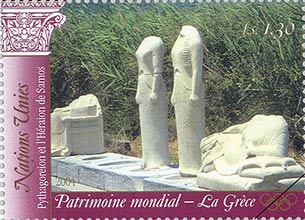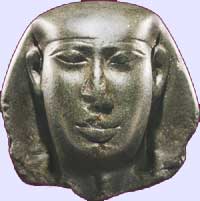.
Wherever he turned his arms, success waited on him. He had a fleet of a hundred penteconters, and bowmen to the number of a thousand. Herewith he plundered all, without distinction of friend or foe; for he argued that a friend was better pleased if you gave him back what you had taken from him, than if you spared him at the first. He captured many of the islands, and several towns upon the mainland. Among his other doings he overcame the Lesbians in a sea-fight, when they came with all their forces to the help of Miletus, and made a number of them prisoners. These persons, laden with fetters, dug the moat which surrounds the castle at Samos. Herodotus, Histories Book 3
Polycrates, son of Aeaces, was the tyrant of Samos from 535 BC to 515 BC.
He took power during a festival of Hera with his brothers Pantagnotus and Syloson, but soon had Pantagnotus killed and exiled Syloson to take full control for himself. He then allied with Amasis II, pharaoh of Egypt, as well as the tyrant of Naxos Lygdamis. With a navy of 100 penteconters and an army of 1000 archers, he plundered the islands of the Aegean Sea and the cities on the Ionian coast of Asia Minor, defeating and enslaving the navies of Lesbos and Miletus. He also conquered the small island of Rhenea, which he chained to nearby Delos as a dedication to Apollo.

World Heritage sites : The Heraion of Samos, sculptures at the Sacred way leading to the monumental Hera Temple.

Amasis,
He had a reputation as both a fierce warrior and an enlightened tyrant. On Samos he built an aqueduct, a large temple of Hera (to which Amasis dedicated many gifts), and a palace later rebuilt by the Roman emperor Caligula. He was a patron of the poet Anacreon, and of the Crotonian doctor Democedes. According to Herodotus, Amasis thought Polycrates was too successful, and advised him to throw away whatever he valued most in order to escape a reversal of fortune. Polycrates followed the advice and threw a jewel-encrusted ring into the sea; however, a few days later, a fisherman caught a large fish that he wished to share with the tryant. While Polycrates' cooks were preparing the fish for eating, they discovered the ring inside of it. Polycrates told Amasis of his good fortune, and Amasis immediately broke off their alliance, believing that such a lucky man would eventually come to a disastrous end.
It is more likely that the alliance was ended because Polycrates allied with the Persian king Cambyses II against Egypt. By this time, Polycrates had created a navy of 40 triremes, probably becoming the first Greek state with a fleet of such ships. He manned these triremes with men he considered to be politically dangerous, and instructed Cambyses to execute them; the exiles suspected Polycrates' plan, however, and turned back from Egypt to attack the tryant. They defeated Polycrates at sea but could not take the island. They then sailed to mainland Greece and allied with Sparta and Corinth, who invaded the island. After 40 days they withdrew their unsuccessful siege.
Herodotus also tells the story of Polycrates' death. Near the end of the reign of Cambyses, the governor of Sardis, Oroetes, planned to kill Polycrates, either because he had been unable to add Samos to Persia's territory, or because Polycrates had supposedly snubbed a Persian ambassador. In any case, Polycrates was invited to Sardis, and despite the prophetic warnings of his daughter, he was assassinated. The manner is not recorded by Herodotus, as it was apparently an undignified end for a glorious tyrant, but he may have been crucified.
Another art of the tyrant is to sow quarrels among the citizens; friends should be embroiled with friends, the people with the notables, and the rich with one another. Also he should impoverish his subjects; he thus provides against the maintenance of a guard by the citizen and the people, having to keep hard at work, are prevented from conspiring. The Pyramids of Egypt afford an example of this policy; also the offerings of the family of Cypselus, and the building of the temple of Olympian Zeus by the Peisistratidae, and the great Polycratean monuments at Samos; all these works were alike intended to occupy the people and keep them poor
Polycrates and the Tunnel of Eupalinos
Pausanias
The first men to melt bronze and to cast images were the Samians Rhoecus the son of Philaeus and Theodorus the son of Telecles. Theodorus also made the emerald signet, which Polycrates, the tyrant of Samos, constantly wore, being exceedingly proud of it.
| Ancient Greece
Science, Technology , Medicine , Warfare, , Biographies , Life , Cities/Places/Maps , Arts , Literature , Philosophy ,Olympics, Mythology , History , Images Medieval Greece / Byzantine Empire Science, Technology, Arts, , Warfare , Literature, Biographies, Icons, History Modern Greece Cities, Islands, Regions, Fauna/Flora ,Biographies , History , Warfare, Science/Technology, Literature, Music , Arts , Film/Actors , Sport , Fashion --- |
Retrieved from "http://en.wikipedia.org"
All text is available under the terms of the GNU Free Documentation License

